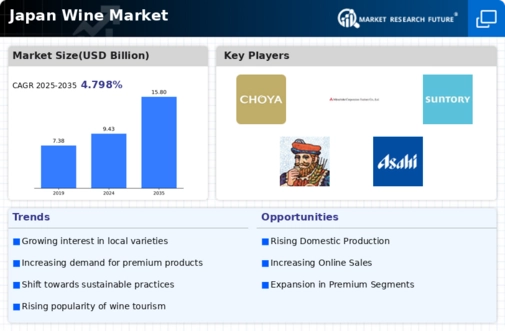Influence of Wine Tourism
Wine tourism is emerging as a notable driver for the wine market in Japan. Regions known for wine production, such as Yamanashi and Nagano, are attracting both domestic and international tourists. This influx of visitors not only boosts local economies but also enhances the visibility of Japanese wines. In 2025, it is projected that wine tourism will contribute to a 20% increase in local wine sales, as tourists often purchase wines as souvenirs. The growing interest in wine tourism suggests that the wine market may benefit from enhanced marketing strategies that promote regional wines and experiences, potentially leading to increased consumer engagement.
Rising Health Consciousness
The increasing awareness of health benefits associated with moderate wine consumption appears to be a driving force in the wine market. Japanese consumers are becoming more health-conscious, leading to a growing preference for wines perceived as healthier options. This trend is reflected in the rising demand for organic and low-sugar wines, which are often marketed as healthier alternatives. In 2025, the market for organic wines in Japan is projected to grow by approximately 15%, indicating a shift towards more health-oriented choices. This evolving consumer behavior suggests that the wine market is adapting to meet the needs of a more health-aware population, potentially influencing product offerings and marketing strategies.
Cultural Integration of Wine
The integration of wine into Japanese culture is gradually transforming consumer perceptions and consumption patterns. Traditionally, sake has dominated the alcoholic beverage landscape, but wine is increasingly being embraced, particularly among younger demographics. This cultural shift is evidenced by the rise of wine bars and tasting events across urban areas, which are fostering a greater appreciation for wine. In 2025, it is estimated that wine consumption in Japan will increase by 10%, reflecting this cultural integration. As the wine market continues to evolve, it may lead to innovative pairings with traditional Japanese cuisine, further enhancing its appeal and accessibility.
E-commerce Growth in Wine Sales
The expansion of e-commerce platforms is significantly impacting the wine market in Japan. With the convenience of online shopping, consumers are increasingly turning to digital channels for their wine purchases. In 2025, online wine sales are expected to account for approximately 25% of total wine sales in Japan, highlighting a shift in consumer buying behavior. This trend is likely driven by the desire for a wider selection and the ability to compare prices easily. As e-commerce continues to grow, it may encourage new entrants into the wine market, fostering competition and innovation in product offerings and delivery services.
Innovative Marketing Strategies
The wine market in Japan is witnessing a shift towards innovative marketing strategies aimed at attracting a diverse consumer base. Brands are increasingly utilizing social media and influencer partnerships to reach younger audiences, who are more likely to explore new wine options. In 2025, it is anticipated that marketing expenditures in the wine market will rise by 30%, reflecting the industry's commitment to engaging consumers through modern channels. This focus on innovative marketing may not only enhance brand visibility but also encourage trial and adoption of various wine styles, ultimately contributing to the overall growth of the market.
















Leave a Comment